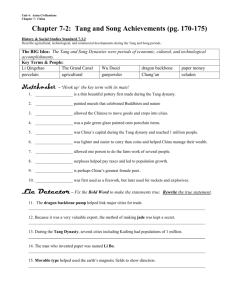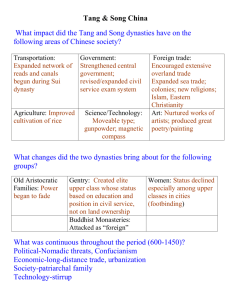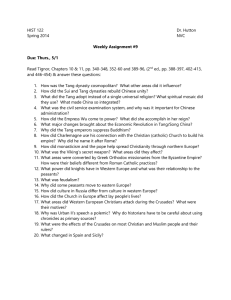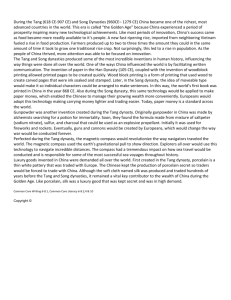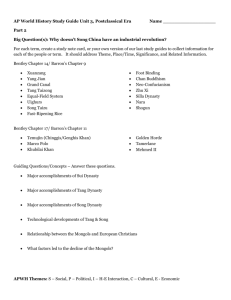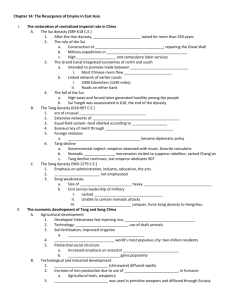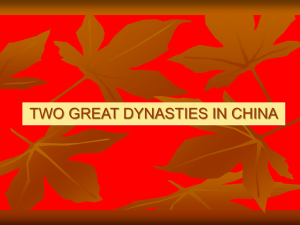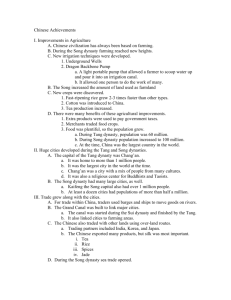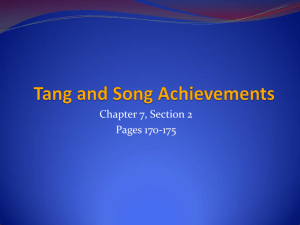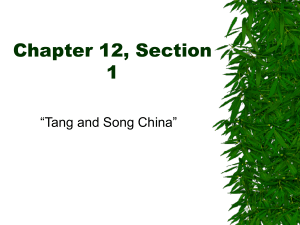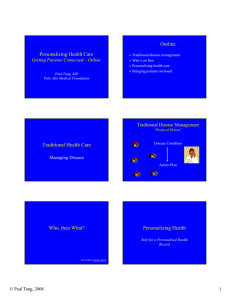Sui, Tang, Song Dynasties
advertisement
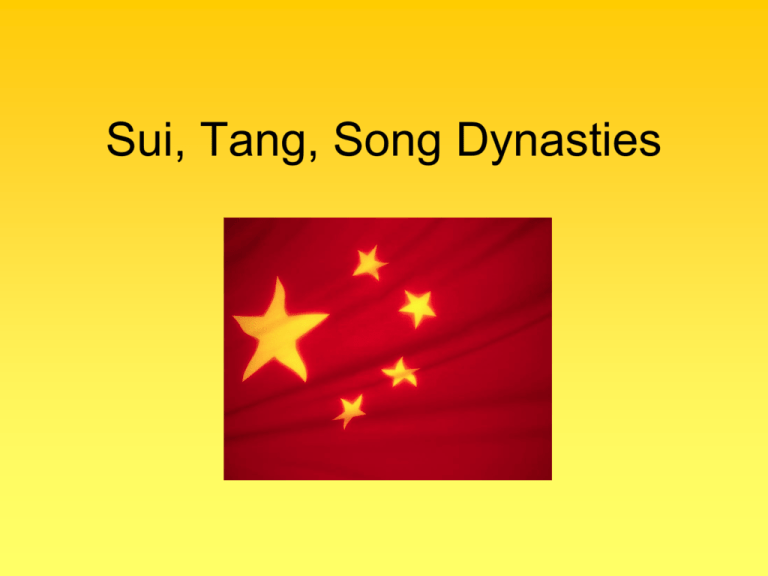
Sui, Tang, Song Dynasties Period of Disunion • 220-589 CE • Period of disunion: the time of disorder that followed the collapse of the Han dynasty Sui Dynasty • 589-618 • Conquered the south and unified China • Known for harsh rule: forced peasants who owed taxes to fight in the army • Created a centralized and unified state and laid the foundation for the golden age that followed Sui Dynasty-Achievements • Repaired and lengthened the Great Wall • Provided security from Northern invaders which allowed cultural and economic growth • Many died while building the wall • Those who died were often buried among the walls bricks: giving the nickname “The world’s longest cemetery” • • • • • Tang Dynasty-Government 618-907 CE: Golden Age of culture China was the richest most powerful country in the world Conquered Vietnam, Tibet, and Korea as tributary states Rebuilt bureaucracy Civil Service exams: ability not rank Tang Dynasty-Government • Only dynasty to have a female emperor: Empress Wu Chao • After her husband died she decided her sons were not capable of ruling • Ruled with an iron fist: if anyone threatened her, they risked being killed • Chose advisors based on ability not rank Tang Dynasty-Economics • After conquering the west, the Tang were able to reopen the silk road- a system for trade, travel, communication, exchange of ideas • Connected China to central Asia and the middle east • From China to west: silk, porcelain, jade, tea, paper, printing, farming methods, weapons • From West to China: glass rugs, horses, silver, medicine, spices, Christianity, Islam Tang Dynasty-Economics • Equal Field System- redistributed land to peasants • Citizens paid taxes on how much land they received • Central Government strengthened: benefited from increased number of taxpayers, limited power of wealthy landowners • Benefited commoners and peasants by giving them a chance to gain wealth Tang Dynasty-Achievements • Built the Grand Canal, which connected the Yellow river in the north and the Yangzi river in the south • Connected northern and southern China • Farmers and merchants in the south (rice) used the canal • Government and military officials could travel and watch over citizens • Many died while building the canal Song Dynasty-Government • 960-1279 CE • Song China was limited to provinces south of the Great Wall • Strengthened the system of meritocracy-jobs based on ability • Stricter civil service exams Song Dynasty-Economy • Chinese farming reached new heights • Irrigation techniques • Dug underground wells • Dragon Backbone pump-light portable pump that allowed farmers to scoop up water and pour it into a canal • Amount of land under cultivation increased • Discovery of fast ripening rice= 2 or 3 harvests a year Tang and Song-Technology • • • • Mechanical Clock (700s) Gunpowder (850) Block Printing (700s) Moveable Type (1040s) Tang and Song-Culture • Landscape paintingsinfluenced by daoism • Pagodas: Temples • Porcelain • Li Bo and Du Fu- famous Chinese poets and Wu Daozifamous artist lived at this time Ming (Brilliant) Dyansty • Tired of foreign rule • Reassert Chinese Greatnessrestored civil service, Confucian learning, and bureaucracy Zhy Yuanzong: Peasant leader that founded Ming dynasty Ming-Economics • Better fertilization=more crops • Many new industries and technologies-led to increased output • Created blue and white porcelain • Better printing methodsled to more books Zheng He 1405-1433 • Chinese Admiral • Led 7 expeditions: fleet had 62 ships and 25,000 sailors. One ship was 400 feet long • Goal: Promote trade, collect tribute, show strength and power of China Zheng He’s Travels • Impressed the Zheng He • Brought back goods, exotic plants and animals, and prisoners of war (people that wouldn’t pay tribute) • China opened Imperial Zoo where they kept all of the animals Zheng He brought back to China
